We left off at Period 3 and its vastly expanded concept of evolution and experiments with the methods through which Pokémon could evolve and be obtained, like evolutionary stones, branched evolutions, and fossil revival. We also saw the first attempts at creating new lines for yet single-stage Period 2 Pokémon, like the Dratini, Machop, Ekans, Paras and Poliwag lines. Period 3 ends with the first instance of a brand new three-stage line added at once with the Weedle line. That pivotal period of development gave momentum to what we label Period 4, which ranges from index numbers 115 to 156.
| ⇐ | INTRO | P1 | P2 | P3 | P4 | P5 | ⇒ |
| MISSINGNO. OVERVIEW | LOST POKEMON OVERVIEW | ||||||
Pokémon of the final two periods (and possibly even Period 3) may have been designed during a relatively short time span, dating probably from late 1993 to mid-1995. In 1994, sometime after Period 3 Pokémon were coded, the crew chose to adapt the game for the newly released Super Game Boy. This is when Pokémon got their colors for the first time:
Sugimori: Game Boys only had black and white as colors. When Pokémon Red & Green was first in development, none of the Pokémon had any colors. They were represented in black and white and were colored that way in pixel-art style. Back when it was in development (in 1994), they released an adapter called the “Super Game Boy” that let you play Game Boy software on television through the Super Famicom. The Super Game Boy had a function that added pseudo-colors to a game, and for the first time we were able to give Pokémon colors.
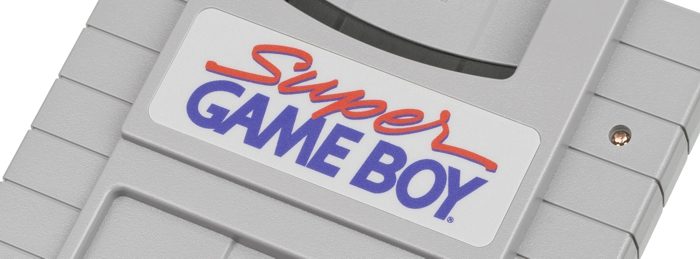
PERIOD 4
You may notice that Period 4 (ID 115-156) both starts and the ends with a MissingNo. of unknown identity. There are patterns underlying the Pokémon that are placed between them that suggest that these MissingNo. also belong to this period. Here is why: the overwhelming majority of Pokémon added in P4 are evolutionary relatives of Pokémon designed in Period 1 and Period 2 – and the single MissingNo. that appear on the outlying spots of this Period fit that pattern more than the tightly bunched evolutions that Period 3 and early Period 5 are characterized by.
We can split this Period into Period 4a and Period 4b, based on evolutionary relations:
- Period 4a (ID 115-132, MissingNo. – Snorlax) – the majority of Pokémon here are related exclusively to the Pokémon added in Period 2, the only exceptions being the self-encapsulated Caterpie line, as well as Snorlax and Mewtwo, which we believe were created for plot purposes; in fact, there are no Pokémon related to any other periods.
- Period 4b (ID 133-156, Magikarp – MissingNo.) is more flexible in that regard, but it focuses mostly on expanding the evolutionary lines of the Period 1 Pokémon, as well as some Period 2d Pokémon.
PERIOD 4a
This pattern can be split even further, as the first part (ID 115-122, MissingNo.- MissingNo.) seems to contain exclusively evolutions of Period 2b Pokémon. It’s possible that MissingNo. 121 and 122 could belong to a different pattern, but it’s more likely that, along with MissingNo. 115, they were relatives to the Pokémon placed within range of 056-071. If single-stage Pokémon like Farfetch’d or even Crocky and Cactus had evolved forms in Generation I, they would most likely be placed in one of these MissingNo. slots. Design-wise, less likely candidates to get an evolution are Deer, Tauros, the elephant Pokémon from slot 061, and Jagg.
After the Caterpie line, the designers focused on evolving the Period 2a Pokémon: (ID 126-130, Machamp – Golbat). Machamp, Golduck and Hypno all relate to P2a Pokémon and are placed in the same order as their pre-evolutions in P2a – Golbat, just like its pre-evolution in Period 3b, sticks out in that regard. However, Missingno 127 (with a modified Rhydon base cry) may also follow this pattern.
In light of all the evidence we have, a likely candidate for spot 127 would be a Pokémon related to Mr. Mime. Its movepool contains a duplicate move (Confusion) which is a characteristic of evolved forms. Combine that with a curious case of the name Baririina appearing both in 1993 poll documents in the Satoshi Tajiri manga, and the Gold and Silver Spaceworld demo where it was a name given to a Mr. Mime pre-evolution, Mr. Mime remains an oddity, and the identity of MissingNo. 127 might be the key to this mystery.
The other likely options for MissingNo. 127 are Pokémon related to Chansey and the Hitmons.
Just like the evolutionary stones in Period 3, the Poké Flute’s place in the item list seems to coincide with the addition of Snorlax to the roster, together with Mewtwo as odd Pokémon that aren’t relatives of the previous designs, but instead serve a story-related purpose.
Morimoto: There would be occasions when the designers would get an order from the scenario writers to create a character that would block the way, say.
PERIOD 4b
Period 4b expands on Pokémon added in Period 1 (as most of them were still single-stage at this point). Later in this group, there is a noticeable tendency to create two new stages at once (Abra, Pidgey, Bulbasaur lines) or link two pre-existing forms with a middle stage (Haunter).
This pattern creates the impression that the numerous MissingNo. that appear in this period were also evolved forms of Period 1 and Period 2 Pokémon and the blurry monsters that we discovered in the GCCX interviews (MissingNo. 134 and MissingNo. 135) fall in this pattern and might be even related to each other. 
These, along with the other MissingNo. of this period, could be basically anything. Some of them might relate to other MissingNo. of the earlier periods – and so there are many options as to their identities. Again if you know where to find a higher than 480p version of the Game Center CX interview with Satoshi Tajiri, please get in touch with us! We could be able to better see – and perhaps discover something from – MNo. 134 and 135.
MissingNo. 137 possesses a cry that is the exact duplicate of Dragonair’s. This could suggest, as is the case with MissingNo. 094 and 095, a saurian, draconic or even amphibian appearance.
One interesting thing to note is that Cloyster and Kingler are listed next to each other, and Pokédex entries mention them as rival species. Maybe they designed these two with that rivalry in mind; we recommend that you read an insightful blog post about this relationship.
PATTERN SUMMARY
- Evolutions. The period follows one clear general direction, which is to expand on P1 and P2 Pokémon by adding evolutions.
| ⇐ | INTRO | P1 | P2 | P3 | P4 | P5 | ⇒ |
| MISSINGNO. OVERVIEW | LOST POKEMON OVERVIEW | ||||||
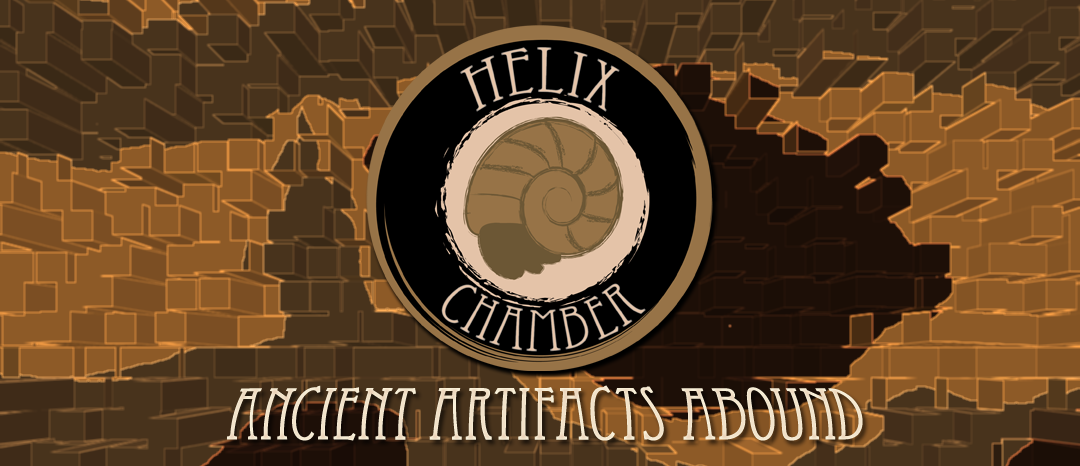

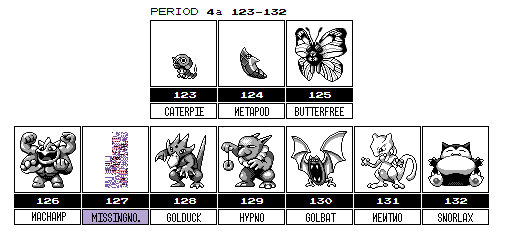
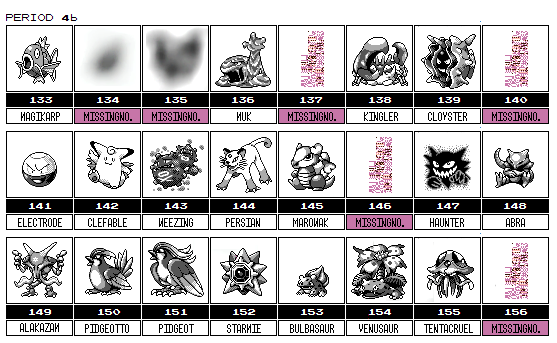
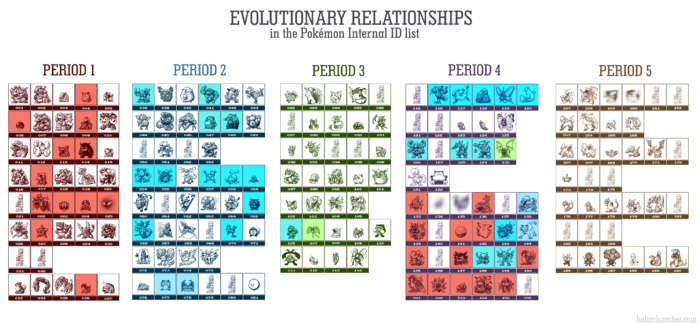
Interesting that the Caterpie line was added all at once. Venonat and Butterfree share very obvious similarities. Caterpie and Venomoth also have similar features. I’ve always thought that Venomoth and Butterfree had their sprites accidentally swapped during development.
At first I thought the internal list was evidence against this, but given that we know sprites were being constantly revised (Lapras is P1 but has a later sprite, for example) based on the polls, there were plenty of opportunities for it to have happened.
Yea! Actually this Internal list analysis neither prove nor disprove the Venomoth/Butterfree connection
It’s strange how many things you got right, but I do wish you’d stop obsessing about Mr. Mime.
Things that need slight correcting is when the eras start/finish. No way baby Goldeen can be cut off from Goldeen and Seaking like that.
Though I do like how you predicted 122 being related to a Pokémon between slots 56-71.
aw well of course we’re planning on updating that, actually a new version of the evo relashionship table is already available on this page https://helixchamber.com/2019/02/16/what-dreams-may-come/
I kinda wish we noticed those could be three three stagers instead of 4 2 stagers, but hey ahahah
I may that the No. 134 is an primal concept of Glaile. But I only may.
Hello, I just wanted to ask, has anybody had any luck with 135? I think I might be onto something, it seems like it’s definitely not a pokemon that we’ve seen before, more to the point, it looks like a 4 legged pokemon.